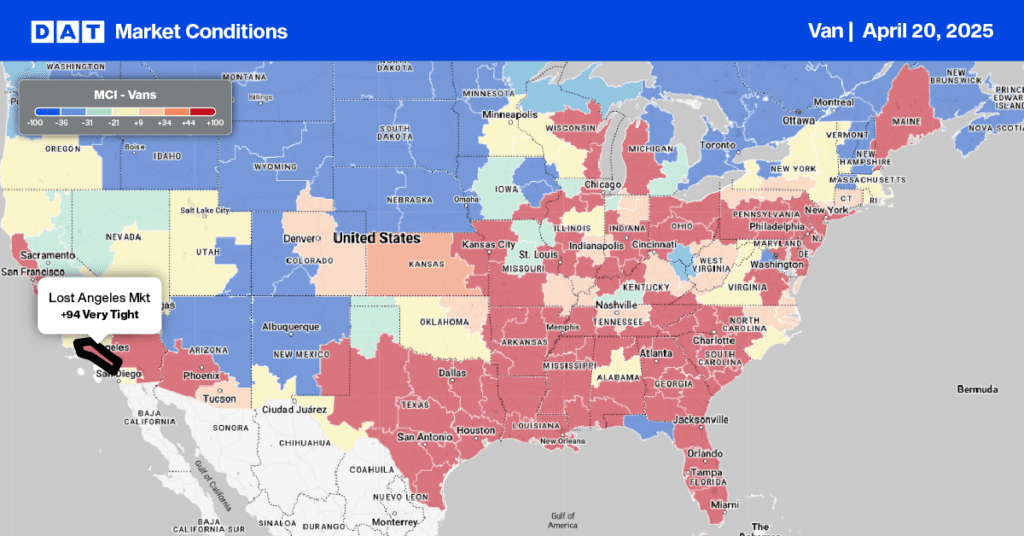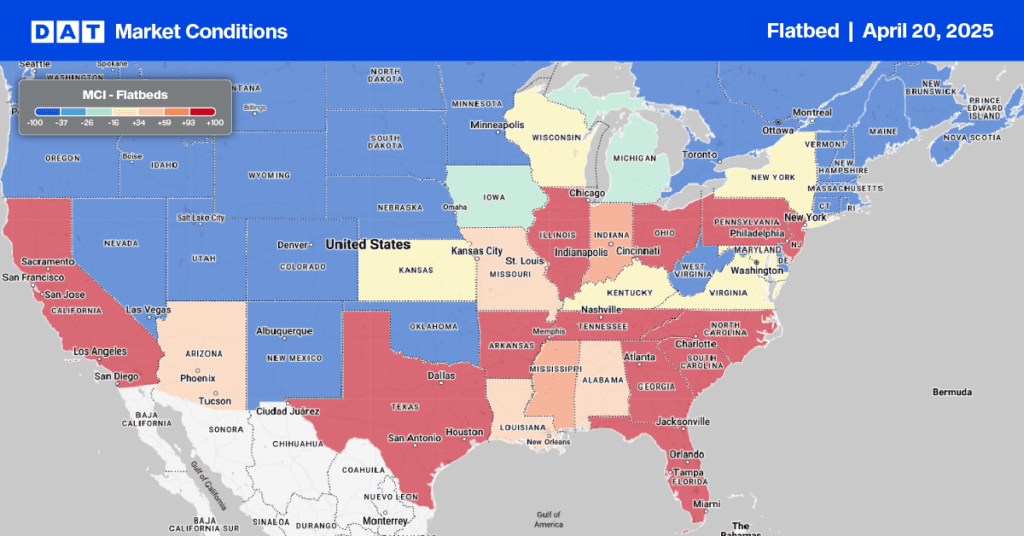New trade policies and tariffs are throwing new challenges to truckers and owner-operators. The market is increasingly harder to read due to fluctuating volumes and unpredictable rates, but opportunities can still be found for those who know how to negotiate smartly.
How can you make sure you’re maximizing your earnings, even in the midst of uncertainty?
Tariffs are shaking things up
Disruptions drive spot market demand. During COVID, we saw this during lockdowns with panic buying, online shopping, stimulus payments, and a surge in freight demand. Today, tariffs are driving the disruption. Shippers pulled freight forward to beat the impacts of tariffs, which caused volumes to spike and then drop.
Now, warehouses are overstocked in many regions, but if orders don’t pick up, we could see more trucks competing for fewer loads. This makes the market incredibly volatile, and truckers must adapt by staying informed and prepared.
Smart negotiation isn’t just about saying “yes” to a rate because the market feels soft; it’s about using data to justify your prices and making decisions that benefit your business long-term.
No one-size-fits-all rate
Every load and every lane is different. It’s especially true now. A reefer hauling fresh produce in California will have a different rate structure than a flatbed moving steel through the Midwest or a dry van hauling retail on the East Coast.
Rates are influenced by your lane, supply and demand, the type of freight you haul, and even the time of year. Always think big-picture. A fair rate for one job might not work for another, and the smartest truckers are those who know the specifics for their lanes and commodities.
Our advice to carriers is to factor in lane-level and regional data when pricing a load. The broader trends shown by national averages can be misleading. While the 30-day national averages give you insight into market shifts, they won’t always reflect the current spot market conditions in your specific area.
For example, a load leaving Texas might yield vastly different rates than running a similar load leaving Florida. Understand where you operate, and don’t rely solely on national averages when negotiating.
Don’t undercut yourself
Everyone is feeling the impact of lower volumes and compressed rates, but it doesn’t mean you should accept a rate that isn’t profitable for your business. The truth is, smart truckers who negotiate well can weather these challenges and come out on top.
Here’s how:
- Know your costs: Understand your operating costs per mile, including fuel, maintenance, and other expenses. A good deal isn’t a good deal if it leaves you operating at a loss.
- Use real data: Tools like DAT’s market data provide accurate, up-to-date rates based on real transactions — not load posts. This ensures you’re negotiating from a strong, informed foundation.
- Pull back the curtain on lane data: Lane-level pricing and regional trends highlight shifts other truckers might overlook. Armed with this information, your negotiation becomes less about gut feelings and more about facts.
- Communicate value: Brokers need reliable, professional carriers to move their loads. If you’re on time, communicate clearly, and perform well, that value adds weight to your rate negotiations. Let them know they don’t need to worry if you’re on the job.
Keep in mind that low rates today don’t define what you deserve tomorrow. Build relationships, and don’t be afraid to hold firm on what your expertise, efficiency, and reliability are worth.
DAT doesn’t set rates
We often hear questions like, “Does DAT set rates for the market?” The answer is a definitive no. DAT doesn’t determine what carriers should haul for. Instead, we provide tools and data to help truckers and brokers negotiate smarter. You’re seeing what others have been paid, not what you should be paid. That’s your call. Making that call is easier when you’re seeing what market rates look like.
Think of DAT rates like Kelley Blue Book, but for freight. Just as Kelley Blue Book gives car buyers and sellers a starting point based on real transactions, DAT’s rates offer insights based on what brokers are actually paying carriers. These rates are aggregated from brokers and carriers’ transportation management systems (TMS) and reflect real numbers, not projections.
Most DAT load board subscriptions come with access to this rate data — giving you an edge when it’s time to negotiate a load.
Remember, you’re in the driver’s seat (literally and metaphorically). DAT rates are a benchmark, not a mandate. With data in hand, you’re better equipped to negotiate confidently with brokers and shippers.
Unlocking even more opportunities
If you’re looking for even deeper insights to fine-tune your negotiation strategy, consider upgrading to a premium data package. This will give you access to historical trends, deeper lane-specific data, and additional insights to help you stay competitive in markets with shifting volumes and rates.
Being proactive about your business isn’t an expense; it’s an investment. With the right tools, you can transform industry challenges into opportunities.
The bottom line
The tariff landscape has created a freight market filled with volatility and opportunity. By understanding how tariffs influence the market, using the right data, and honing your negotiation skills, you can stay competitive — even in uncertain times.
Truckers who view rates as a conversation, not a challenge, are the ones who come out ahead. Lean on the power of lane-level data and tools like DAT’s rate insights to ensure every load you move is worth your time and effort.
At DAT, we’re here to support every mile you run, no matter how the industry shifts.
Check out these relevant DAT U courses and videos to help understand and negotiate rates.
DAT U courses
Maximizing your profits on the road
How route planning drives profit
Videos
- Learn about the best DAT One tools to negotiate higher rates
- How to negotiate the best price for a load
- Using the Quick Rate Lookup tool
- Using the Profit Estimator
- How to post a truck (with a rate)
- Use these DAT tools to negotiate a higher rate with brokers


